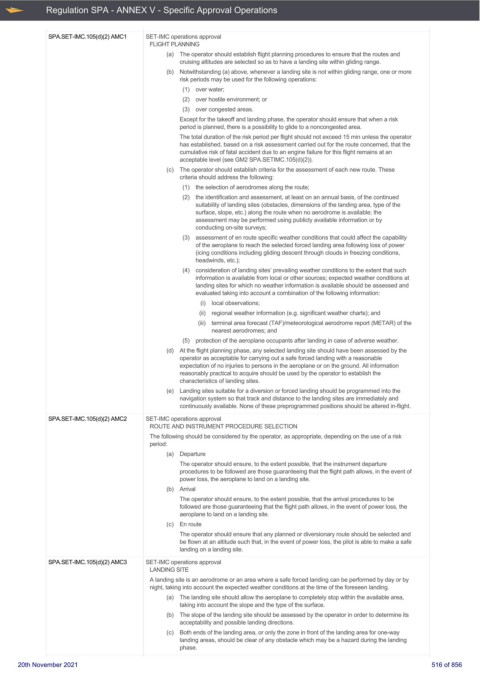Page 516 - UK Air Operations Regulations 201121
P. 516
~
~ Regulation SPA - ANNEX V - Specific Approval Operations Centrik
SPA.SET-IMC.105(d)(2) AMC1 SET-IMC operations approval
FLIGHT PLANNING
(a) The operator should establish flight planning procedures to ensure that the routes and
cruising altitudes are selected so as to have a landing site within gliding range.
(b) Notwithstanding (a) above, whenever a landing site is not within gliding range, one or more
risk periods may be used for the following operations:
(1) over water;
(2) over hostile environment; or
(3) over congested areas.
Except for the takeoff and landing phase, the operator should ensure that when a risk
period is planned, there is a possibility to glide to a noncongested area.
The total duration of the risk period per flight should not exceed 15 min unless the operator
has established, based on a risk assessment carried out for the route concerned, that the
cumulative risk of fatal accident due to an engine failure for this flight remains at an
acceptable level (see GM2 SPA.SETIMC.105(d)(2)).
(c) The operator should establish criteria for the assessment of each new route. These
criteria should address the following:
(1) the selection of aerodromes along the route;
(2) the identification and assessment, at least on an annual basis, of the continued
suitability of landing sites (obstacles, dimensions of the landing area, type of the
surface, slope, etc.) along the route when no aerodrome is available; the
assessment may be performed using publicly available information or by
conducting on-site surveys;
(3) assessment of en route specific weather conditions that could affect the capability
of the aeroplane to reach the selected forced landing area following loss of power
(icing conditions including gliding descent through clouds in freezing conditions,
headwinds, etc.);
(4) consideration of landing sites’ prevailing weather conditions to the extent that such
information is available from local or other sources; expected weather conditions at
landing sites for which no weather information is available should be assessed and
evaluated taking into account a combination of the following information:
(i) local observations;
(ii) regional weather information (e.g. significant weather charts); and
(iii) terminal area forecast (TAF)/meteorological aerodrome report (METAR) of the
nearest aerodromes; and
(5) protection of the aeroplane occupants after landing in case of adverse weather.
(d) At the flight planning phase, any selected landing site should have been assessed by the
operator as acceptable for carrying out a safe forced landing with a reasonable
expectation of no injuries to persons in the aeroplane or on the ground. All information
reasonably practical to acquire should be used by the operator to establish the
characteristics of landing sites.
(e) Landing sites suitable for a diversion or forced landing should be programmed into the
navigation system so that track and distance to the landing sites are immediately and
continuously available. None of these preprogrammed positions should be altered in-flight.
SPA.SET-IMC.105(d)(2) AMC2 SET-IMC operations approval
ROUTE AND INSTRUMENT PROCEDURE SELECTION
The following should be considered by the operator, as appropriate, depending on the use of a risk
period:
(a) Departure
The operator should ensure, to the extent possible, that the instrument departure
procedures to be followed are those guaranteeing that the flight path allows, in the event of
power loss, the aeroplane to land on a landing site.
(b) Arrival
The operator should ensure, to the extent possible, that the arrival procedures to be
followed are those guaranteeing that the flight path allows, in the event of power loss, the
aeroplane to land on a landing site.
(c) En route
The operator should ensure that any planned or diversionary route should be selected and
be flown at an altitude such that, in the event of power loss, the pilot is able to make a safe
landing on a landing site.
SPA.SET-IMC.105(d)(2) AMC3 SET-IMC operations approval
LANDING SITE
A landing site is an aerodrome or an area where a safe forced landing can be performed by day or by
night, taking into account the expected weather conditions at the time of the foreseen landing.
(a) The landing site should allow the aeroplane to completely stop within the available area,
taking into account the slope and the type of the surface.
(b) The slope of the landing site should be assessed by the operator in order to determine its
acceptability and possible landing directions.
(c) Both ends of the landing area, or only the zone in front of the landing area for one-way
landing areas, should be clear of any obstacle which may be a hazard during the landing
phase.
20th November 2021 516 of 856

